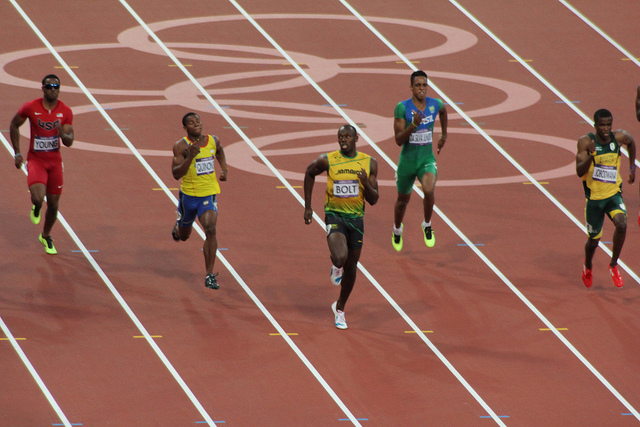More speed is something that every athlete wants. No matter what sport you play, nobody got worse by getting faster. The sad thing is that it’s a very common belief that you can’t train speed, that some people are born fast. Nothing could be further from the truth, especially for short distances such as a 40 yard dash. In this article I will explain how I went from running a 5.69 hand-timed 40 and almost being moved to offensive line to running a 4.58 electronic 40 and running sprints on a D1 track team.
Understanding the 40 Yard Dash
The most important thing to realize with the 40 yard dash is that it is almost entirely acceleration based. Only for the last 10 yards are you at full speed in a phase known as max velocity. This is great because acceleration is primarily a function of strength to body weight ratio which can be easily trained, rather than max velocity which is more influenced by genetics. A good example of this would be De’Anthony Thomas, who is capable of running a fantastic 10.31 100 meter but only ran a 4.50 40 yard dash at the NFL combine. This is because while he has fantastic top end speed, he lacks the strength required to have great acceleration off the line.

Acceleration would be in the power and explosive strength portion of this graph along with things like the vertical jump and standing long jump. This is why, surprisingly, some of the best vertical jumps and standing long jumps are by linebackers and running backs, not wide receivers and defensive backs like you would expect.
This should be motivational for you because it shows that you aren’t doomed to be slow, getting faster is simply physics. Produce more force with the same amount of resistance and you will be faster.
Putting It Into Action
So now that we have an understanding of what the 40 yard dash is about, how do we actually improve it? Many people make this much more complicated than it needs to be, really it can be broken down into 2 steps
- Increase strength
- Increase rate force development to turn that strength into speed
Our goal is to get as strong pound for pound without sacrificing rate force development in the form of unwanted muscle fiber conversion from fast twitch to slow twitch. To do this we will combine speed work and strength work together to constantly convert new strength gains into speed and explosiveness.
Getting Stronger
Entire books have been written on the subject if strength training so we’ll focus on the simple stuff that has been proven to work again and again. I found over the course of my athletic career that the more simple I made things the better results that I saw. I stopped doing all the crazy exercises and instead did basic exercises with consistency. This is what let me take my squat from 245 to 425 and my bench from 145 to 235 over the course of one summer.
The workout I did was dead simple, almost entirely compounds with a few auxiliary lifts thrown in for good measure. The workouts were full-body, done 3 times a week, and alternated ABA ,BAB. Your goal is to add 5lbs to your squat every workout, 15lbs a week. The same is to be done for the other exercises, though you will stall out faster on these. If you want to see the exact workouts I did to get my results check out my Ebook, The Athlete Blueprint. There’s nothing sexy about compound lifts and being consistent but if you do it you will see results
Getting Faster
In addition to the strength training we will also be doing speed work such as sprints and plyometrics. One of the things that few people do to get faster is actually run fast, which always amazes me. If you wanted to get better at shooting 3 pointers you would shoot 3 pointers, so why wouldn’t you do the same for getting faster?
The key thing about speed work that most people don’t get is that it has to be done with full recovery between reps and sets. Without full recovery you aren’t able to hit the highest threshold fast twitch muscle fibers, which basically means you are wasting your time. Think about it like this, do athletes at the NFL combine run a bunch of sprints right before running their timed 40? Of course not, they want to be as fresh as possible so they can run the best time possible, so why would your training be any different? If you want to run fast you have to train fast, quality is always better than quantity when it comes to speed work.
So, for speed work to improve your 40 yard dash you will want to keep two things in mind
- Always get full recovery in between reps
- Keep the distances short
Because the 40 yard dash is about 75% acceleration based the majority of your speed work will be focusing on acceleration, typically 10-20 yard sprints with extra focus on your starting technique. You will also want to do some max velocity work like flying 10 and 20 yard sprints and ins-n-outs to improve your top end speed. A typical speed session should be between 250-500 yards of sprints.
Putting it all together
The beauty of this program is that the speed and strength training work symbiotically to result in massive results. The strength gains are constantly being converted into power by the speed work, with this extra power resulting in more speed.
Most programs will separate this into two phases training phases, which results in the athlete taking 1 step forward and two steps back. During the strength phase the athlete loses speed and unwanted slow twitch muscle fiber conversion occurs. During the speed phase the athlete has to regain these things, and the emphasis on speed causes to athlete to lose the hard earned strength from the previous phase.
Conclusion
The training principles in this article, known as vertical integration, have been used by athletes at every level, from high school to the pros, to see massive results. If you follow these principles with consistency you will see results that you never thought possible. If you want the full program check it out here.


